clearance watches sale at Goldsmiths outlet plus free delivery watches, diamonds, gift and jewellery until july 26. See clearance watches at Goldsmith
MY COLLECTING HOBBIES
THIS BLOG IS ABOUT MY COLLECTING HOBBIES OF DIFFERENT THINGS LIKE CURRENCY, COINS, STAMPS, FLAGS ETC
Friday, September 14, 2012
Wednesday, October 5, 2011
No. 10 San Antonio, TX
People say they come here for the historic Alamo, but it could very well be the queso- and chile-sauce-slathered Tex-Mex: San Antonio ranked in the top 10 for both ethnic fare and barbecue. If you want to get off the tourist grid, head to Southtown, south of downtown, to try the gastropub The Monterey or The Friendly Spot, an ice house with tamales, tostadas, and a dizzying long list of microbrews.
No. 9 Charleston, SC
This South Carolina city embraces its traditional low-country cuisine — southern cooking with a heavy dose of coastal oysters, crab, and shrimp. Stroll around the historic district and you’ll see (and smell) plenty of foodie magnets like the new HUSK, helmed by James Beard Award–winner Sean Brock. It’s another charming side to Charleston, which readers voted No. 1 for quaint neighborhoods, B&Bs, and friendly, attractive locals.
No. 8 Savannah, GA
This Georgian city may be known for its coastal-themed fine dining, but AFC voters love it best for its small cafés — home-cooking “neighborhood diners” with a local-ingredients bent. One popular spot: the Green Truck Pub, which offers appetizers such as spiced Georgia nuts and a pimento cheese plate. Readers also find the city nicely unpretentious, with a relaxing vibe, good cocktails, and entertaining people-watching.
No. 7 Seattle
The Pike Place Market is perhaps the most photographed farmers’ market in the country — and it’s right across the street from the original Starbucks (here coffee is practically its own food group). A hot neighborhood for new restaurants is nearby South Lake Union, where homegrown chef Tom Douglas recently opened three restaurants, including Tibetan-themed Ting Momo.
No. 6 Portland, OR
Super-green Portland has earned a reputation for its farm-to-table dining, well-crafted microbrews, and 200-odd food trucks. To get a sampling of the most popular — including Namu, excellent Korean-Hawaiian fusion — check out the food truck “pods” at Pioneer Courthouse Square or at SE Hawthorne and 12th Avenue. And don’t be fooled by the notion that these Oregonians are totally health-conscious: another culinary must-stop is Voodoo Doughnuts for its bacon-topped maple bar and the breakfast-cereal-crusted “Captain My Captain.”
No. 5 Chicago
The Windy City clearly makes people hungry: it ranked in the top 10 for burgers, big-name restaurants, and ethnic cuisine and — perhaps no surprise — took the top prize for pizza. But thanks to places such as Lillie’s Q and Pork Shoppe, Chicago may soon boost its middle-of-the-road standing in the barbecue category. There are also a number of Japanese barbecue-style robata restaurants, such as Roka Akor and Tokio Pub.
No. 4 New York
While the Big Apple may be a nerve center for big-name restaurants, luxury hotels, and diversity, New Yorkers can eat well at any price point and have embraced the food trucks and comfort-dining crazes. Evidence includes long lines at midtown street vendors, SoHo’s newcomer The Dutch, and the expanding Shake Shack franchise. Foodies are also increasingly heading to the outer boroughs for authentic, affordable fare, such as Chinese in Flushing, Queens.
No. 3 Providence, RI
For Rhode Island foodies, farm-to-table is just the beginning. Some great restaurants in Providence — such as Chez Pascal on Hope Street, or Nick’s on Broadway, in the West End — offer “boat-to-table” seafood that comes direct from local fishermen. AFC voters also love the homey vibe of this New England city: they ranked it third for its hole-in-the-wall cafés, burgers, and pizza (which some locals like grilled).
No. 2 San Francisco
The Bay Area’s Chez Panisse is still the mothership for foodies, but there are plenty more restaurants serving sustainable, seasonal cuisine, among them Baker and Banker in Pacific Heights. You have to keep moving to find the next hotspots, and food-truck lovers follow Off the Grid, a weekly circling of food wagons in different parts of town. San Francisco also scored in the top 5 for ethnic fare, coffee bars, and farmers’ markets. One hot trend: gourmet grilled cheese sandwiches.
No. 1 New Orleans
If you’re going to keep up with the nonstop party in the Crescent City, you’ll need a full stomach. New Orleans won the survey for neighborhood cafés, and came in No. 2 for its zesty ethnic fare. The post-Katrina rebuilding has extended deep into its restaurant scene, with chefs updating classic Creole cuisine at spots such as Meson 923 in the up-and-coming Warehouse District, and Sylvain in the French Quarter. While you’re waiting for a table, you can engage in one of the town’s great sports: people-watching.
AMERICA'S BEST CITIES FOR FOODIES
No. 10 San Antonio, TX
People say they come here for the historic Alamo, but it could very well be the queso- and chile-sauce-slathered Tex-Mex: San Antonio ranked in the top 10 for both ethnic fare and barbecue. If you want to get off the tourist grid, head to Southtown, south of downtown, to try the gastropub The Monterey or The Friendly Spot, an ice house with tamales, tostadas, and a dizzying long list of microbrews.

Charleston, SC
No. 9 Charleston, SC
This South Carolina city embraces its traditional low-country cuisine — southern cooking with a heavy dose of coastal oysters, crab, and shrimp. Stroll around the historic district and you’ll see (and smell) plenty of foodie magnets like the new HUSK, helmed by James Beard Award–winner Sean Brock. It’s another charming side to Charleston, which readers voted No. 1 for quaint neighborhoods, B&Bs, and friendly, attractive locals.

Savannah, GA
No. 8 Savannah, GA
This Georgian city may be known for its coastal-themed fine dining, but AFC voters love it best for its small cafés — home-cooking “neighborhood diners” with a local-ingredients bent. One popular spot: the Green Truck Pub, which offers appetizers such as spiced Georgia nuts and a pimento cheese plate. Readers also find the city nicely unpretentious, with a relaxing vibe, good cocktails, and entertaining people-watching.

Seattle
No. 7 Seattle
The Pike Place Market is perhaps the most photographed farmers’ market in the country — and it’s right across the street from the original Starbucks (here coffee is practically its own food group). A hot neighborhood for new restaurants is nearby South Lake Union, where homegrown chef Tom Douglas recently opened three restaurants, including Tibetan-themed Ting Momo.
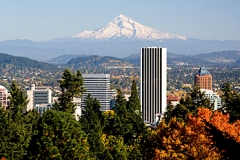
Portland, OR
No. 6 Portland, OR
Super-green Portland has earned a reputation for its farm-to-table dining, well-crafted microbrews, and 200-odd food trucks. To get a sampling of the most popular — including Namu, excellent Korean-Hawaiian fusion — check out the food truck “pods” at Pioneer Courthouse Square or at SE Hawthorne and 12th Avenue. And don’t be fooled by the notion that these Oregonians are totally health-conscious: another culinary must-stop is Voodoo Doughnuts for its bacon-topped maple bar and the breakfast-cereal-crusted “Captain My Captain.”
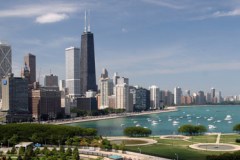
Chicago
No. 5 Chicago
The Windy City clearly makes people hungry: it ranked in the top 10 for burgers, big-name restaurants, and ethnic cuisine and — perhaps no surprise — took the top prize for pizza. But thanks to places such as Lillie’s Q and Pork Shoppe, Chicago may soon boost its middle-of-the-road standing in the barbecue category. There are also a number of Japanese barbecue-style robata restaurants, such as Roka Akor and Tokio Pub.
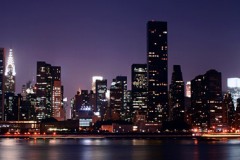
New York
No. 4 New York
While the Big Apple may be a nerve center for big-name restaurants, luxury hotels, and diversity, New Yorkers can eat well at any price point and have embraced the food trucks and comfort-dining crazes. Evidence includes long lines at midtown street vendors, SoHo’s newcomer The Dutch, and the expanding Shake Shack franchise. Foodies are also increasingly heading to the outer boroughs for authentic, affordable fare, such as Chinese in Flushing, Queens.

Providence, RI
No. 3 Providence, RI
For Rhode Island foodies, farm-to-table is just the beginning. Some great restaurants in Providence — such as Chez Pascal on Hope Street, or Nick’s on Broadway, in the West End — offer “boat-to-table” seafood that comes direct from local fishermen. AFC voters also love the homey vibe of this New England city: they ranked it third for its hole-in-the-wall cafés, burgers, and pizza (which some locals like grilled).
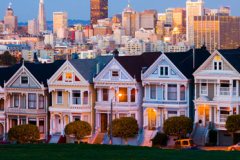
San Francisco
No. 2 San Francisco
The Bay Area’s Chez Panisse is still the mothership for foodies, but there are plenty more restaurants serving sustainable, seasonal cuisine, among them Baker and Banker in Pacific Heights. You have to keep moving to find the next hotspots, and food-truck lovers follow Off the Grid, a weekly circling of food wagons in different parts of town. San Francisco also scored in the top 5 for ethnic fare, coffee bars, and farmers’ markets. One hot trend: gourmet grilled cheese sandwiches.
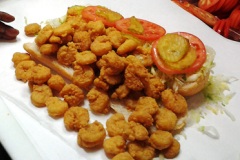
New Orleans
Courtesy of Parkway Bakery
No. 1 New Orleans
If you’re going to keep up with the nonstop party in the Crescent City, you’ll need a full stomach. New Orleans won the survey for neighborhood cafés, and came in No. 2 for its zesty ethnic fare. The post-Katrina rebuilding has extended deep into its restaurant scene, with chefs updating classic Creole cuisine at spots such as Meson 923 in the up-and-coming Warehouse District, and Sylvain in the French Quarter. While you’re waiting for a table, you can engage in one of the town’s great sports: people-watching.
WORLD TOP 10 CASTLE
Neuschwanstei Castle
Royal palace in the Bavarian Alps of Germany, the most famous of three royal palaces built for Louis II of Bavaria, sometimes referred to as Mad King Ludwig, who grew up nearby at Hohenschwangau Castle.
PALACE OF VERSAILLES
The Palace of Versailles was the official residence of the Kings of France from 1682 until 1790. It was originally a hunting lodge, built in 1624, by Louis XIII. It was expanded by Louis XIV beginning in 1669. He used it as a little lodge as a secret refuge for his amorous trysts with the lovely Louise de la Valliere and built a fairy tale park around it. Jules Hardouin Mansart, the king’s principal architect, drew the plans to enlarge what was turning more and more into a palace from A Thousand and One Nights. The terrace that overlooked the gardens was removed to make way for the magnificent Hall of Mirrors, the Galarie de Glaces. It is here from which the king radiated his power and where the destiny of Europe was decided over a century. The French classical architecture was complemented by extensive gardens.
CHENONCEAU
Chenonceaux, small agricultural community in the department of Indre-et-Loire in northwestern France,18 miles east of Tours. Located on the Cher River. Chenonceaux is best known as the site of the 16th-century Chateau de Chenonceaux, which is situated on the north bank of the river.
In 1515 Thomas Bohier, revenue collector for King Francis I, began the construction of the Chateau de Chenonceaux. Unfinished at the time of his death, construction of the chateau was completed by Bohier’s wife and son. In 1535, however, Francis I took the estate in payment of debts. King Henry II, son of Francis I, gave the chateaux to Diane de Poitiers, duchesse de Valentinois, who extended the structure by a bridge across the Cher. Catherine de Medicis, widow of Henry II, forced Diane de Poitiers to deed the chateaux to her. Catherine de Medicis constructed the gallery above the bridge and the stables known as the Batiment-des-Dames. The chateau became her favorite residence, and it was there that her son Francis II and Mary, Queen of Scots, were married in 1560.
In 1515 Thomas Bohier, revenue collector for King Francis I, began the construction of the Chateau de Chenonceaux. Unfinished at the time of his death, construction of the chateau was completed by Bohier’s wife and son. In 1535, however, Francis I took the estate in payment of debts. King Henry II, son of Francis I, gave the chateaux to Diane de Poitiers, duchesse de Valentinois, who extended the structure by a bridge across the Cher. Catherine de Medicis, widow of Henry II, forced Diane de Poitiers to deed the chateaux to her. Catherine de Medicis constructed the gallery above the bridge and the stables known as the Batiment-des-Dames. The chateau became her favorite residence, and it was there that her son Francis II and Mary, Queen of Scots, were married in 1560.
The Chateau of Chambord
Chambord, chateau, park, and village in the department of Loire-et-Cher in central France. The chateau of Chambord was a retreat for French kings, especially Louis XIV It was under his auspices that French dramatist Moliere’s Monsieur de Pourceaugnac and Le bourgeois Gentilhomme were first produced there.
Linderhof
Ludwig II built this secluded hunting lodge, it was known as the Kings Hut. Ludwig decided that this will be a New Versailles. It was planned as a modest villa but had become a splendid Rococo palace in the ornate French style. Linderhof is the smallest of the three royal castles, and the only one which was completely finished. (1878).
Tower of London
Castle building was an essential part of the Norman Conquest; when Duke William of Normandy invaded England in 1066 his first action after landing was to build a castle.After his coronation in Westminster Abbey on Christmas Day 1066, William ordered the construction of a castle in London for his triumphal entry. nitially the Tower had consisted of a modest enclosure built into the south-east corner of the Roman City walls, but by the late 1070s, with the initial completion of the White Tower, it had become the most fearsome of all. Nothing had been seen like it in England before. It was built by Norman masons and English (Anglo-Saxon) labor drafted in from the countryside. It was intended to protect the river route from Danish attack, but also and more importantly to dominate the City physically and visually.The White Tower was protected to the east and south by the old Roman City walls (a full height fragment can be seen just by Tower Hill underground station), while the north and west sides were protected by ditches as much as 750m (25ft) wide and 3.40m (lift) deep and an earthwork with a wooden wall on top. It is important for us today to remember that the functions of the Tower from the 1070s until the late 19th century were established by its Norman founders. The Tower was never primarily intended to protect London from external invasion, although, of course, it could have done so if necessary. Nor was it ever intended to be the principal residence of the kings and queens of England, though many did in fact spend periods of time there. Its primary function was always to provide a base for royal power in the City of London and a stronghold to which the royal family could retreat in times of civil disorder.
Leeds, Kent
Leeds Castle, acclaimed as the most romantic castle in England, is located in south-east England, built on two adjacent island in the river Len.Leeds Castle was originally a manor of the Saxon royal family possibly as early as the reign of Ethelbert IV ( 856-860). The first castle was an earthwork enclosure whose wooden palisade was converted to stone and provided with two towers along the perimeter. This is now vanished. Traces of arches in a vault thought to be Norman were found at the beginning of this century. Around 1119 Robert Crevecoeur started to build a stone castle on the site, establishing his donjon where the Gloriette now is. Stephen, Count of Blois, and his cousin the Empress Matilda contested the crown of England. In 1139 Matilda invaded England with the help of his brother Robert, Earl of Gloucester, who held Leeds castle, but Kent was loyal to king Stephen and following a short siege he took control of the castle.The castle came into the possession of Edward I (1278) . He rebuilt much of the castle as it stood at the beginning of his reign, and enlarged it, providing an outer stone curtain round the edge of the larger island, with cylindrical open-backed flanking towers and a square-plan water-gate on the south-east. The gatehouse at the south-west, a single tower pierced by an arched passage was improved.Henry VIII, the most famous of all the owners of Leeds Castles, expended large sums in enlarging and beautifying the whole range of buildings. At the same time, he carefully retained the defenses of the castle for he often had cause to fear invasion from either France or the Spanish . The king entrusted the work of alteration to his great friend Sir Henry Guidford.Leeds has been constantly inhabited and rebuilt since then. Most of the castle today is the result of the nineteenth-century reconstruction and addition.
Blois
Dominating the Loire River, the royal castle of Blois is not only one of the most prestigious Renaissance monuments in France but also a brilliant illustration of the evolution of the French architecture from the Middle ages to the 17th century.About the middle of the 10th century, the name of Thibaud I is recorded Count of Blois, he was the founder of the family who remained in power until 1230. Blois became the most important town in the region. The first stone castle was built to protect the town dates back to that period. An independent bastion surrounded the castle, and followed the line of the headland on which it was erected. The numerous medieval remains still exists. The best preserved medieval tower is situated on a terrace overlooking the Loire.While the Franco-Anglo was (named the Hundred Years War) raged in the real, an event took place that determined the future of the county of Blois, the ancient fortress became a royal castle. At the end of the 14th. century, the county of Blois was sold to Prince Louis of Orleans, son of the king of France Charles V. He lived in the castle for 25 years attracting a small court of scholars and poets. His grandson, Louis XII became king of France in 1498 and decided to move to Blois, in this way, the small town became a royal town and the capital of the Kingdom.Under Louis XII and Francis I the town of Blois grew considerably. But after the disaster of Pavia in 1525, Francis I never returned to Blois and his successors only paid short visits to the town. According to French and Gothic tradition, the initials and emblems of the owners of the place are sculptured in the stone: fleur de lis for the king and ermine spots for the queen, Anne de Bretagne. The equestrian statue of the king crowns the main entrance of the castle. The emblem of the king, the salamander, is sculptured eleven times in high relief on the Francis I facade. The staircase, which was at the center of the facade before Gaston d”Orleans began to modify the castle is a masterpiece. When the Italianate straight flights of stairs appeared in the Loire Valley after the Gothic period, the shape of the spiral staircase in a protruding octagonal cage was considered rather ordinary. The staircase, with its three floors of balconies looking on to the Court of Honor, is perfectly suitable for the display of more and more sumptuous ceremonies.
Nymphenburg
The former summer residence of the rulers of Bavaria is located in the west part of the city in the middle of one of Munich’s most beautiful parks. Five generations of Wittelsbach rulers were involved in the construction of this Baroque castle.
The building of Nymphenburg Castle began in the reign of the Elector Ferdinand Maria: overjoyed by the birth of his son and heir, Max Emanuel, he had the central section built for his wife in the style of an Italian villa (Agostino Barelli, 1664-74). In about 1700, Max Emanuel commissioned Enrico Zuccali and Antonio Viscardi to extend the castle by adding galleries and pavilions.The central section owes its present appearance to the efforts of Josef Effner, who in 1715, designed the pilasters, arched windows and busts that now grace the exterior. A few years later, the south section of the castle was added to serve as the court stables. As a counterpart, the orangerie was added to the north.Central section: Stone Hall (Steinerner Saal; 1755-57) with ceiling frescoes by J. B. and F Zimmermann (Homage to the Goddess Hora); the Rococo stucco work is based on designs by Cuvillies.
The building of Nymphenburg Castle began in the reign of the Elector Ferdinand Maria: overjoyed by the birth of his son and heir, Max Emanuel, he had the central section built for his wife in the style of an Italian villa (Agostino Barelli, 1664-74). In about 1700, Max Emanuel commissioned Enrico Zuccali and Antonio Viscardi to extend the castle by adding galleries and pavilions.The central section owes its present appearance to the efforts of Josef Effner, who in 1715, designed the pilasters, arched windows and busts that now grace the exterior. A few years later, the south section of the castle was added to serve as the court stables. As a counterpart, the orangerie was added to the north.Central section: Stone Hall (Steinerner Saal; 1755-57) with ceiling frescoes by J. B. and F Zimmermann (Homage to the Goddess Hora); the Rococo stucco work is based on designs by Cuvillies.
Mont St. Michael
Le Mont-Saint-Michel, rocky, cone-shaped islet in northwestern France, in the Gulf of Saint-Malo, connected by a causeway with the mainland. The islet, celebrated for its Benedictine abbey, has small houses and shops on its lowest level. Above these stand the monastic buildings, many of which date from the 13th century and are considered outstanding examples of Gothic architecture. The entire islet is crowned by the abbey church, about 73 m (about 240 ft) above sea level.The first chapel on this site was founded in 708 by Aubert, Bishop of Avranches , after the Archangel Michael has appeared to him in a dream. The Archangel Michel appeared here in the year 708. The Abbey takes the name of Mont saint Michel. The oratory, consecrated in 709 was served by a community of canons. It apparently survived the Norman invasions, but the observance of the rule became very relaxed. In 966 Richard I, Duke of Normandy, established there the Benedictine monks from St. Wandrille Abbeyunder the direction of Abbot Maynard, who began the reconstructions of the church and other buildings. The church was burnt in 922 and rebuilt on a larger scale by Abbot Hildebert II from 1023, at the time of the monastic reforms in Normandy carried out by Richard II and William of Volpiano. Mont Saint-Michel was built in a strong rock that measures 84 meters height. It is pure granite and is so hard that has resisted the passage of time.Mont Saint Michel was built as a medieval castle. It has two large towers to defend the entrance to the castle. St. Michael is a surety for freedom and thus this sanctuary also became a symbol of the allied landing in Normandy during the Second World War.
WORLD MOST FAMOUS CITIES
Subscribe to:
Posts (Atom)




























































